
 |
A few nights previously I was located at Beaghmore Stone Circles with John Fagan battling with gaps in the clouds as we picked off various deep sky objects and comet C/2023 H2 Lemmon with our 10" F/5 reflectors when the subject was brought up about how quiet this Autumn has been for sky action. It seemed that ever since our action-packed Summer of thunderstorms nature has bowed her head and took a step off the stage making for a fairly quiet period for photogenic transient phenomena. John and I discussed it at length and decided that the only way nature could redeem herself is if she produced a brilliant aurora display between now and Christmas.
Two days later it was as if nature had been listening in our conversation and suddenly the Sun stirred to life. I will confess that since things had been so quiet recently I had eased back somewhat on my relentless following of everything spaceweather related so I was somewhat taken aback when news emerged that several CMEs were heading for Earth with the prospect of G1 and G2 geomagnetic storms. Then on Saturday night November 4th/5th the first CME arrived bringing a fairly decent aurora display for many, however the cloud forecast was very poor with just random clear gaps so this discouraged me from driving out. Others did see aspects of the show, a large green and red band covered the sky at a high altitude however it seemed the display was rather devoid of rays, perhaps due to a fairly slow solar wind speed despite a very good negative Bz.
That being said I did send the drone up and managed to faintly capture the aurora behind the northern slope of Slieve Gallion however the images were not good enough to share. I decided to let this night go and just relax inside and rest, because for some unknown reason I had a strong instinct that Sunday night was going to deliver *if* the other CME/s arrived and didn't miss. I slept uneasily this night because I was anticipating events working out on Sunday night and yet again I had no idea why I was feeling so strongly about this when there was no firm evidence to justify my state of building excitement.
I woke on Sunday morning, switched on the lap top with sleepy eyes, and immediately found out that the second CME had just hit, and it was a proper hit too, sending the Bz very far south with high density, the impact ignited a frenzy of posts on social media about what might be in store after dark. My eyes smarted with the news and at first I was excited, but then it dawned on me that the impact was too early. It was a very long time to darkness and more often than not with these early impacts the activity waned in the hours ahead so I kept my excitement in check. However, I was getting moderately optimistic and in the back of my head I was thinking what if the third CME hit later in the day?, the timing would be perfect, it could be a big show, could we be so lucky?
I had a cup of tea (decaf please) then returned to the lap top and when I did I was astonished to read that the third CME had just hit at approximately 10.00 UT, I couldn't believe it. That's three CMEs in total with two arriving within an hour or so of each other, and again this was a good hit with the Bz at -30, in all likelihood it was the expected full halo CME. Some of the forecasts predicted strong to major storming with G2 to G3 levels on the hours ahead, now I was getting excited! But it was the same dilemma, it would still be 8.5 hours until darkness, such thoughts create dizzying nerves, especially when you know a major show was likely.
I spent the day out and about with Roisin and Rhua. No matter where we went, even inside shops, I couldn't shake this feeling of intensity I was getting. I was feeling very agitated, on edge, and couldn't concentrate on anything else other than aurora prospects. As the day went on this feeling grew stronger, I was actually getting a pronounced and sustained period of anxiety. My fingers and legs felt trembly, almost light and uncomfortable, I was starting to get a mild headache and my stomach felt uncomfortable. Then I felt like I was getting surges of adrenaline, flight or fight mode and even palpitations in my chest, the sensation was most bizarre however I knew what was going on. I should inform readers that I'm not a person of high anxiety, this was not a random panic attack, this was instinct, a foreboding, that something major was going to happen with nature, a sort of premonition.
You see over the years I've developed a strong instinct about sky events, prior to a cool event I will get these feelings, I felt it before the aurora of 2012, before certain thunderstorm events, during the Comet Neowise apparition, and even before the G3 aurora we captured earlier this year, and now I was feeling it again. My instincts were telling me that something special was going to happen with nature this night and I needed to listen to them and I needed to be sharp or I would miss out, I always trusted my instincts.
I never checked the internet all day incase the activity dropped and I would be let-down, which I couldn't handle after this adrenaline surge, then when we arrived home I checked online with some trepidation. Relief swept over me and I smiled with delight when I saw that the charts were great, density high, Bz -27, the oval chart was large and blood red covering a vast area of the northern hemisphere, it was game on. There was no question that the aurora was going to be visible after dark, which was only two hours into the future, the question now was where to go and what was the situation with the weather.
It was a showery airmass with clear gaps forecast between showers on a SWly flow which seemed fine, even the models didn't show that many showers and the day was sunny with plenty of blue skies so things looked good. That is until I checked radar, that's when the atmospheric hammer came down, it showed a massive area of showers moving in from W to E, a large cluster, practically a trough, which was much worse than any forecast showed. Going by their location they would be moving into my target area exactly at night fall, I couldn't believe it. SAT images showed low and mid level cloud with only a few breaks, this was classic N. Ireland weather trying to mess things up again. Now was not the time to be sorrowful, it was time to think fast and make good smart decisions. I chatted with all my mates on our plans, everything was chaos, one model showed one thing, the other another, some thought it was game over and others thought we had a good chance of breaks. Originally I was planning on going to Beaghmore again, then the North Coast, then Fermanagh, then Portglenone, then I decided to go back to Beaghmore, that is until Paul Martin said that Omagh was completely clouded out and it looked bad.
I chatted with forecaster Owain Rice and fellow storm chaser Conor McDonald, we discussed models, radar, sat imagery, common sense. Owain suggested E was better as the showers were being fed by the warmer ocean as they moved inland so W would be worse. Conor said he noticed on radar that once the showers reached the Maghera area they seemed to just die as if they met an imaginary wall. This was all very logical to me so I threw caution to the wind and decided to go E, but not too far. The plan was to head back to the wind turbine farm near Swatragh where we watched the last aurora earlier in the year, it was E of Maghera and offered a high and relatively dark vantage point, and we had wind turbines if we needed them for foreground, I agreed to met Conor at 18.15, I packed a flask, all my gear, and hit the road.
I arrived at the Swatragh wind turbines at exactly 18.15 and a few minutes later Conor arrived too. At first things were not inspirational at all, it was 99% flat cloud with periodic drizzle. I said to Conor will see anything at all?, it didn't look good, however Conor said he had a feeling it was going to clear. No sooner had he said that when breaks began to open at random, we could see that the entire N sky was glowing even with the presence of cloud so something was going on there, but we couldn't see it yet, then good clear gaps appeared in the W so I took a random exposure in that direction, and was delighted to see a red beam on camera. Conor and I were buzzing, at least that was a start, but something was odd, why was this beam so far away from the position of the auroral arc?, in fact, it seemed entirely displaced, and why was it entirely red and not green lower down, also why was it angled away from the arc, we didn't think much else of it at the time.
Conor and I excitedly wondered if we had a chance of getting a corona tonight with such a strong storm, so with broken cloud overhead I took another exposure and there was that red beam again, not a large oval or irregular patch like a corona but that straight red beam again, this didn't make any sense, we began to speculate that something unusual was happening. It clouded over again so we joked saying imagine STEVE appeared, we laughed at the prospect, neither of us had observed this phenomena in our lives before. A large clearance suddenly opened in the E and there on stage was a glowing form unlike anything we had seen before, visually we then we followed it all the way back across the zenith where it could even be seen through thin cloud as a long bright bar or ribbon of light going all the way to the W horizon, then the realization hit us, it was STEVE!
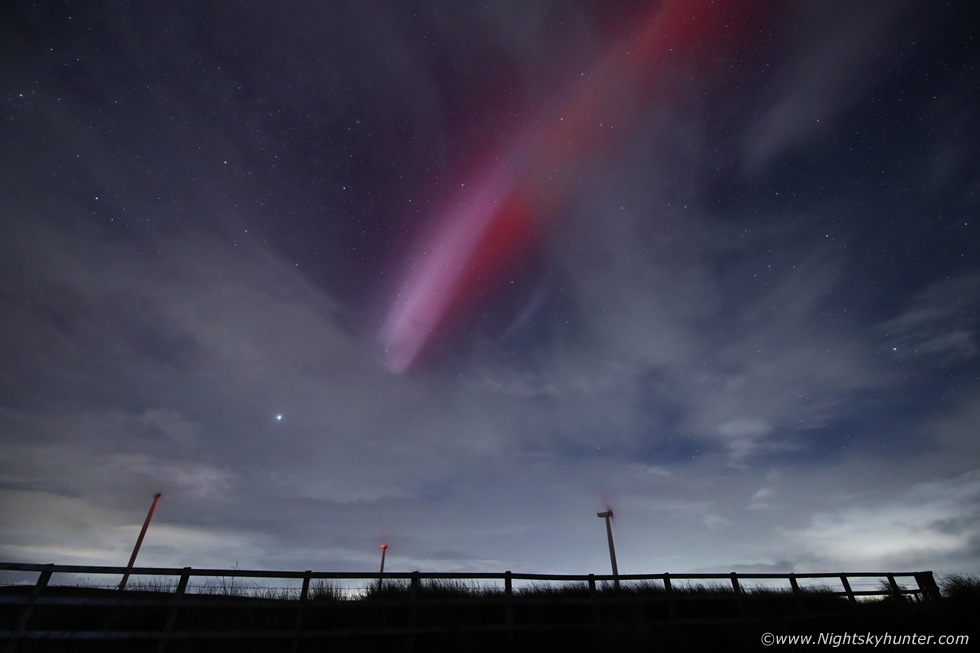 |
I quickly lifted the camera and turned to the E and took a 5 sec exposure and when I looked at the image I was blown away. Striking crimson and purple colours almost exploding out of the camera, it almost looked photo shopped, by nature - STEVE was stunning! I yelled to Conor to get an image of it quick in case it clouded over and when he got it on camera he let out a yell, we were buzzing. Following this a verbal eruption of wows, yells, and cursing, we were in awe and just couldn't believe what we were seeing. We have been observing auroras visually for a very long time, for me personally my first aurora was August 1998 so that was 25 years ago, during that time I've observed 180 auroras from this country, however never once have I knowingly seen STEVE so this was a very rare and special event and as far as I was concerned if it clouded over for the rest of the night I wouldn't have been annoyed, this image alone was a trophy I was more than happy with.
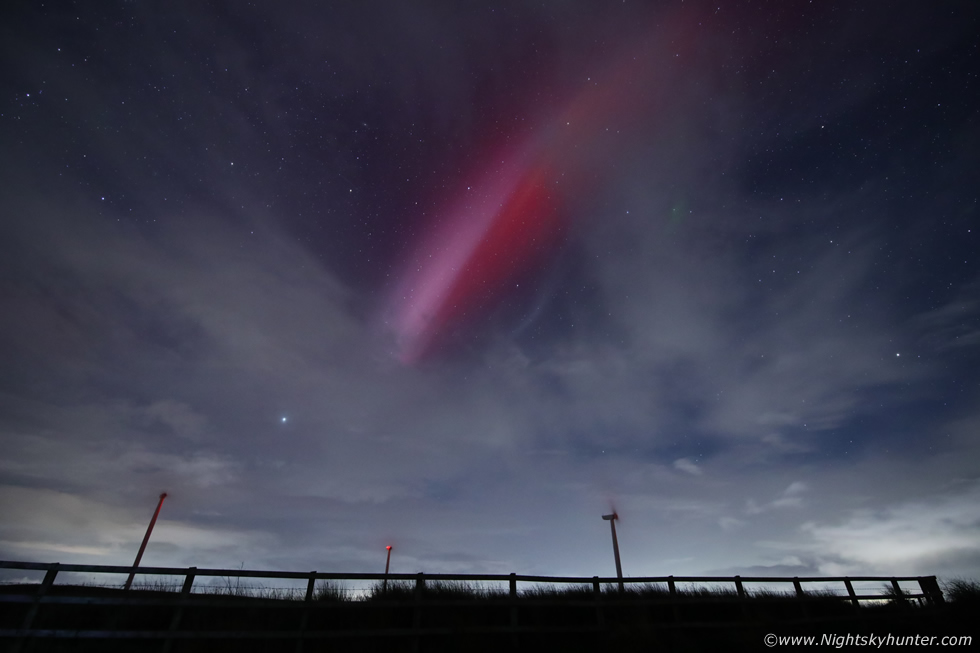 |
STEVE was located in proximity to planet Jupiter (bright star lower left) with the Andromeda Galaxy M31 above, breaks in the cloud almost seemed to frame this atmospheric entity, it was a very dramatic and picturesque moment. Note the vibrant red band associated with STEVE, more on that later. The Green colour to the right of centre isn't a lens flare, it's another rare auroral phenomena called the 'Picket Fence' although only a small section of it has manifested in the sky. Conor and I struggled to come up with a visual description of what we were seeing as STEVE seemed to wax and wane, swell and bulge, and change shape like a Banshee. Conor likened it to a celestial funnel cloud or tornado changing shape.
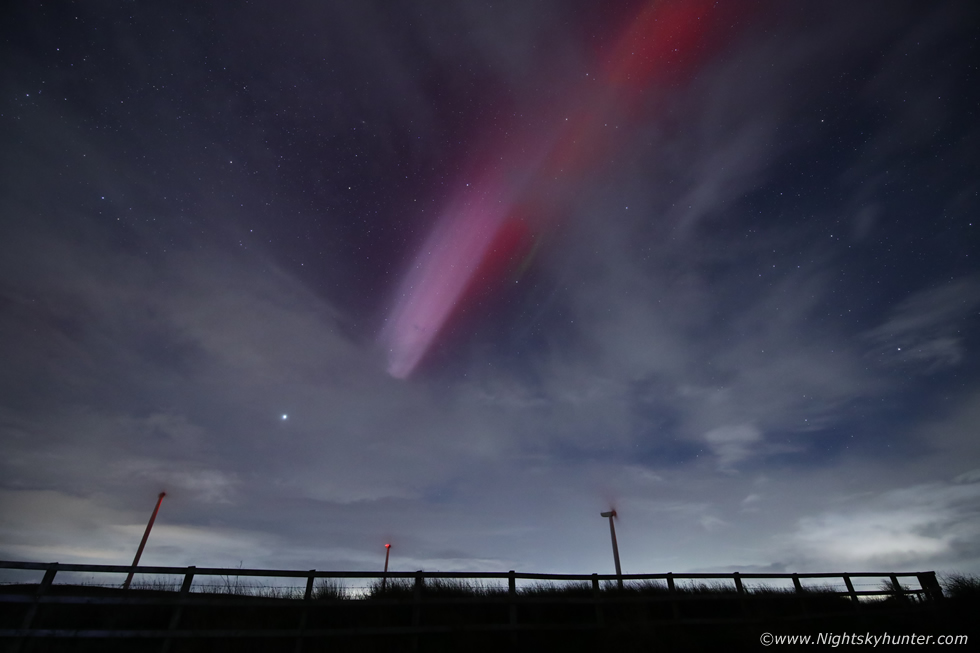 |
With the naked eye it was the brightest and most obvious form in the sky, we began to see fine linear filament structures within the main area which reminded me of the structure of a feather. Notice the green form has now become elongated and changed position with other fainter colourless streaks below. I began shooting a time lapse of this rare event even though as I was conscious of more patchy cloud moving in from the W'
 |
This truly was a night of personal discovery and even though we were familiar with seeing STEVE via images online from higher latitudes we didn't fully understand exactly what it was. I used to think STEVE was a type of proton arc, however I soon learned that this naming is incorrect, protons can't be seen with the naked eye so it's something else entirely. STEVE isn't part of the aurora however it is associated with it, especially more so with severe geomagnetic storms, in truth it's actually an atmospheric phenomena.
STEVE stands for 'Strong Thermal Emission Velocity Enhancement' and was only named during 2016 so even though it has been around for as long as the Earth's magnetic field has existed its a relatively new phenomena to get recorded and identified. STEVE likely is associated with a fast moving stream of extremely hot particles called a subauroral ion drift (SAID). It's thought that STEVE is caused by a river of hot plasma moving at a speed of some 13,300mph or 21,400km/sec which creates friction with the surrounding air causing the molecules to glow much in the same way as the aurora. It always appears displaced away from the main auroral arc and extends from W to E across the sky.
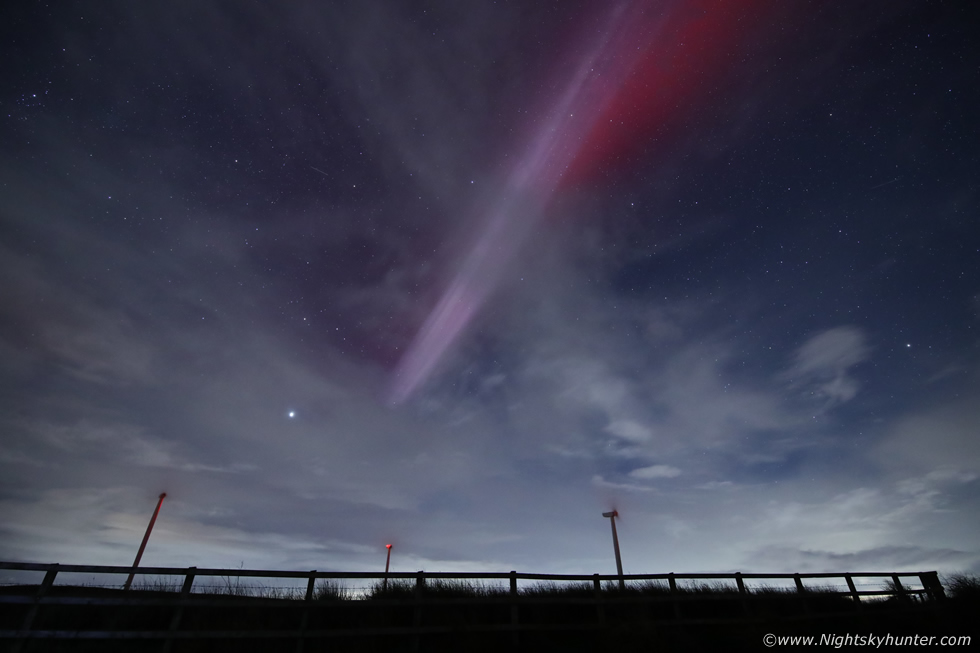 |
Conor and I continued to yell at the sky with delight, STEVE was getting much longer and was so bright it required no dark adaption at all to see, it was that obvious. I followed it from the E, through the zenith facing S then into the W, it looked like a beam or bar crisscrossing the sky, at a first glance we thought it was a moonlit contrail, but there were no planes and the sky was moonless so it took a few seconds for our brain's to register what was happening. You can easily discern the streaks inside STEVE here, it's easy to imagine those particles moving across the high atmosphere at remarkable velocity, this effect was visible visually too.
 |
It became more narrow and at this stage reminded me of photographs of the huge dust tail on the great sungrazing comet Ikeya-Seki of 1965. Then the clouds obscured the show once more, so focused was our excitement that we forgot all about the northern sky.
 |
Facing W with STEVE as a purple laser beam crossing the entire sky where we then lost it within Aquila and Ophiuchus. While all this was going on the N was a blaze with a brilliant milky glow where the vast auroral arc was partially hidden behind cloud. In the gaps we observed enhancements and intense regions which was an indication that an outbreak of rays was likely.
 |
We climbed over the gate into the grounds of the wind turbines just as the sky began to clear properly, an outburst was in the process of happening. We quickly set-up up the gear at a random location and began shooting a time lapse, I was using the Canon 5D Mark IV full frame with 15mm F/2.8 lens, the settings were ISO6400 for 4 sec's. The auroral arc extended across 120 degrees of sky from W to E, it was massive, its E portion was within Auriga not far to the left of Jupiter. Then from nowhere rays began to appear, the show had begun.
 |
Arc in the process of transitioning into a rayed-arc. To the naked eye this was a large curved green-white enhancement like a very bright false twilight in the wrong part of the sky. Within seconds fine vertical rays began to appear, at first low down and diffuse then gradually growing brighter and taller as the Bz component dropped further south once again, as the aurora brightened the more obvious the colours became with the naked eye.
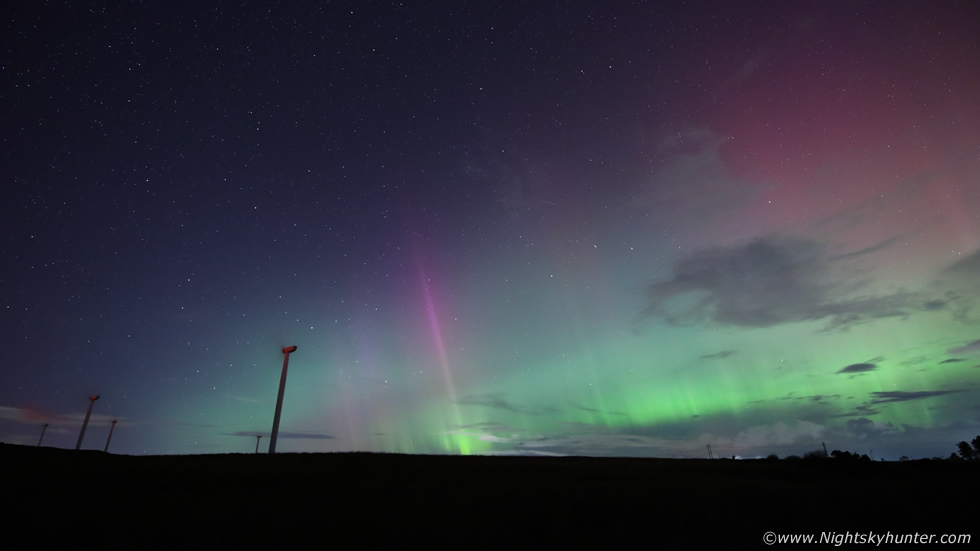 |
I began shooting another time lapse, then Conor and I stood back to watch the show. We sipped warm mugs of tea and ate snacks as the rays increased in number and height, several took on beam-like forms or pencil thin rays embedded within a multitude of diffuse rays. Then as if a switch had been flipped the rays grew very tall, in fact, the tallest we have seen for many years. The upper portions of these developed magenta and red colours which we could easily see with the naked eye. The entire auroral arc was alive with rays slowly meandering across the sky from NW to NE, it was difficult to know where to watch or even where to aim the camera as everywhere was a flurry of action.
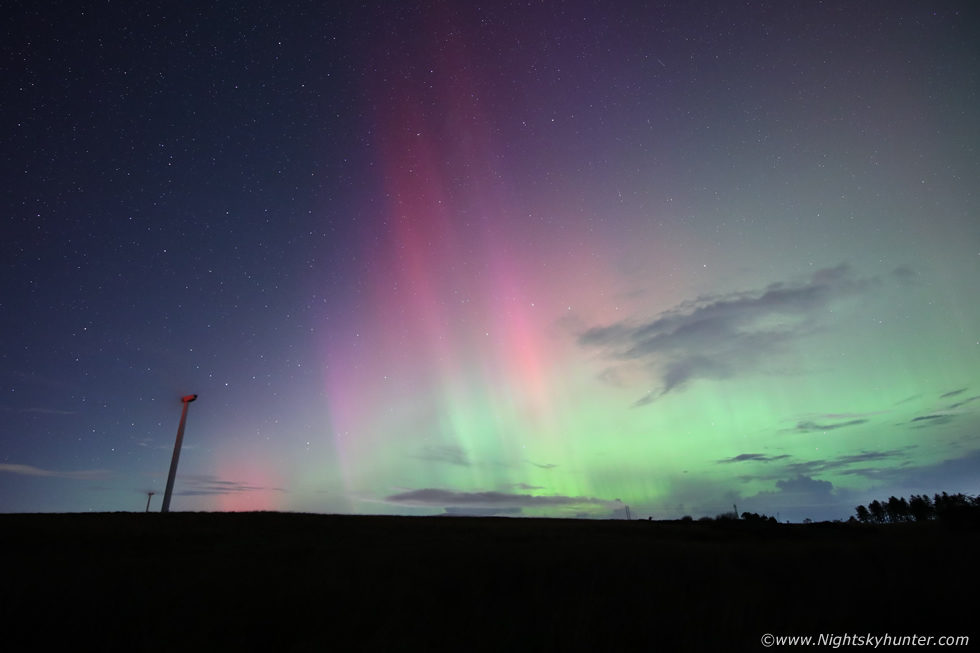 |
The rays were green below and red on top and so tall they began filling the wide angle field of view while spearing the circumpolar star fields of Draco and Ursa Minor, in fact, we could see the tip of the rays extending beyond Polaris. As we stood watching it was like some phantom painter was brushing the sky vertically, this really was Mother Nature at her finest. We looked around and couldn't believe how lucky we had been with the sky, it was perfectly clear in all directions and looked to stay that way for the foreseeable, talk about fortunate, I wondered how Paul, John and Nigel and Colleen were getting on, my phone was quiet so they must have been busy shooting away.
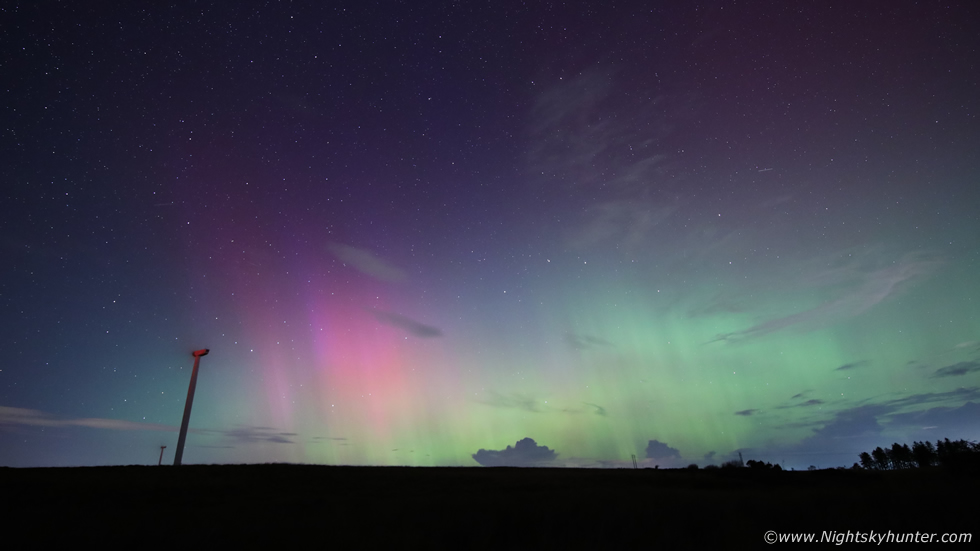 |
While watching this it occurred to me, why don't I give the drone a try with this one?, I had deliberately brought it with me in the van and had forgotten about it until now. I've tried several aerial aurora images before but they were weak displays and the images were sorry at best so I had made a mental note to hold off until a proper aurora appeared, a major storm would make for the perfect test and that's exactly what was happening rite now. I said to Conor I'm going to try the drone and ran off through the wet marsh, over the gate, and back to the van.
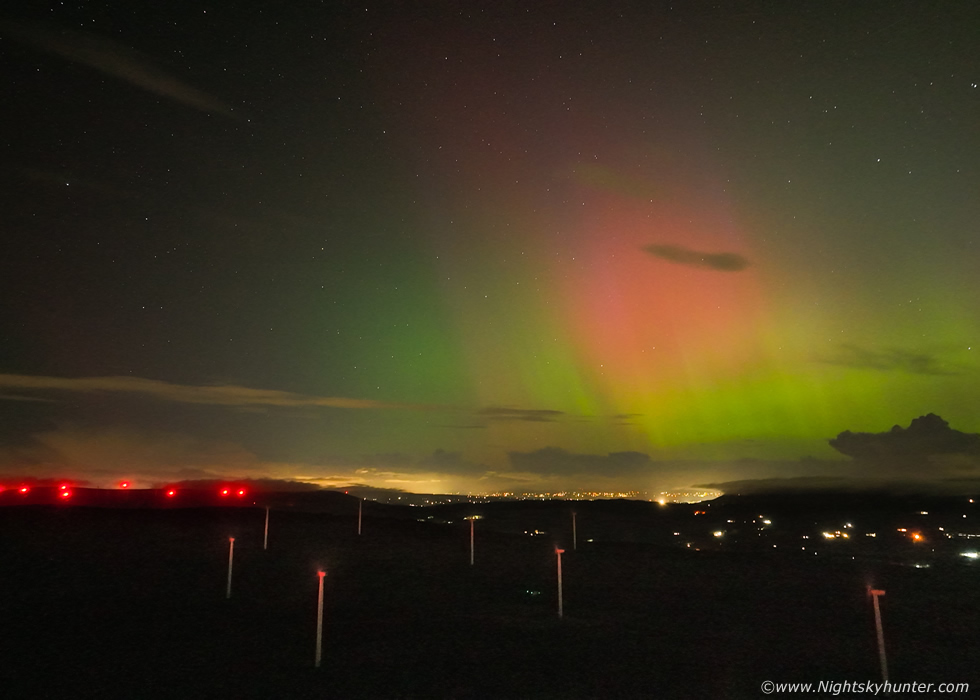 |
I really didn't know what to expect, I leveled the drone at 100m altitude, went into manual mode (or pro mode as DJI call it now), selected a manual white balance, shutter speed of 8 sec's, F/2.8, ISO1600, I could have went for a higher ISO but it those tend to get very noisy so I settled for 1600, auto focused on distant lights to get infinity then began taking exposures. When I previewed them I was astonished to see a bright aurora, the first few images had motion blur in the stars, but I let the drone steady itself and took more, and amazingly even at 8 sec's I was getting images with almost point-like stars from an aerial platform, that's also factoring in a keen breeze at that height too. Hats off to DJI for making such a stable drone and that four thirds sensor really came into its own for a rare subject like this. I like the way I could see the wind turbines below leading into the aurora.
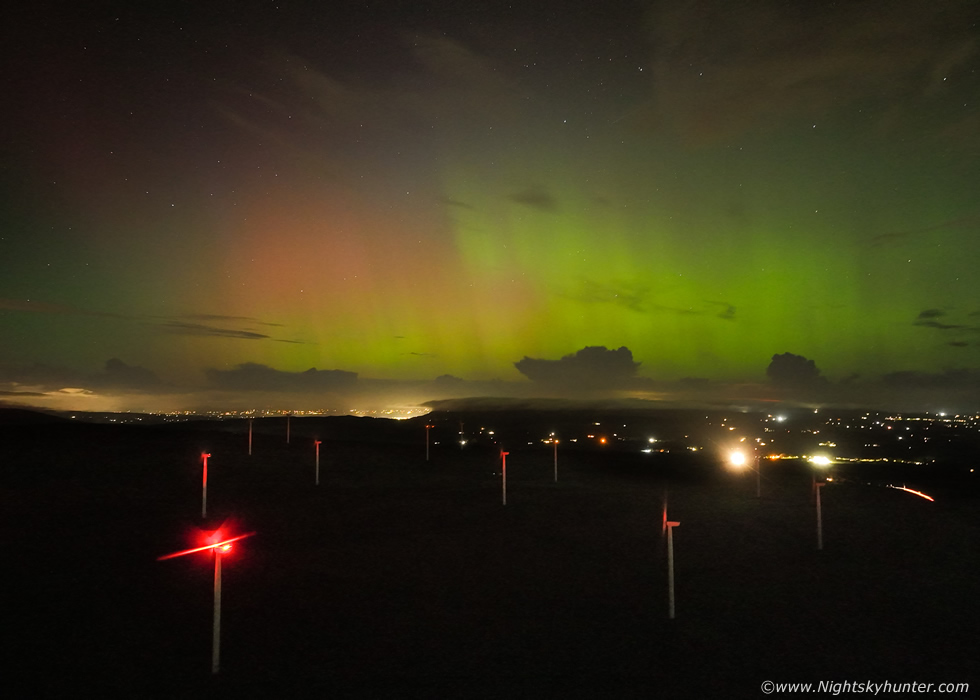 |
I was yelling into the darkness towards Conor saying I was getting the aurora on the drone easily, I will confess I got quite a kick out of this just for something completely different, it was such a novelty to do. I like the dark convective showers on the horizon, likely over the sea, it would have been cool if one of them sparked, there was instability in that area. This was actually the outburst slowly waning and yet it came out so well, it makes me wonder now if a truly severe or extreme geomagnetic storm hit then the results would be even better again, I felt encouraged to experiment again in the future. I'm also wondering now about a drone time lapse or hyper lapse, although the results might not be smooth or perfect but it could be worth a try.
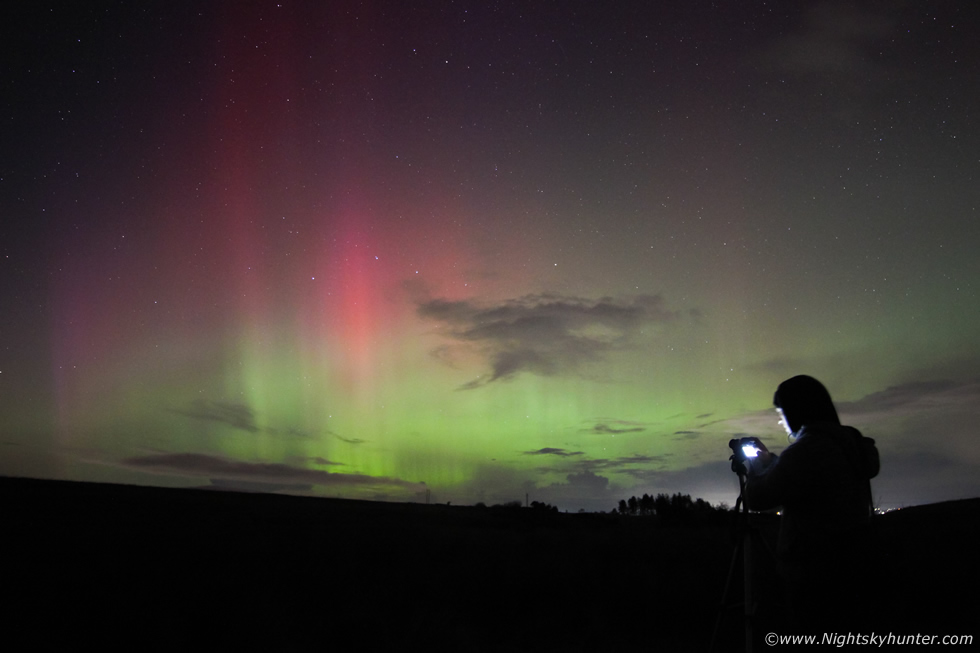 |
I want back into the turbines and joined Conor again, he was buzzing, informing family members what he was seeing over the phone. He was getting great images with his Nikon crop sensor which had the frame filled with beams, we were on such a high, could this night really get any better?. Image of Conor with camera and aurora using my old 600D at 10mm.
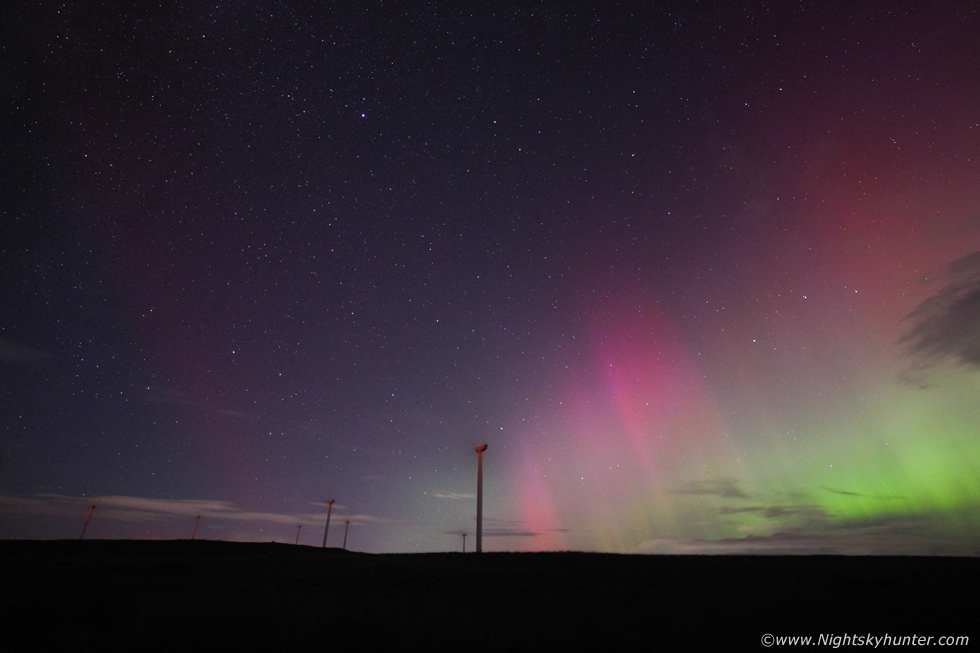 |
It was interesting experimenting with the two cameras for stills and time lapse, with the full frame I found the perfect settings was ISO6400 between 4 and 6 sec's depending on the intensity of the display at any given time, of course the shorter the exposure the better for freezing the rays for more photogenic structure shots. However with my old crop sensor which could only use ISO1600 I had to use exposures of 13-15 sec's, both with wide angle F/2.8 glass. This was with the crop sensor showing beautiful colours, but look very carefully to the empty space on the left hand side, do you see a faint red beam isolated and extending beyond the top of the frame?. I noticed it on camera at the time but I assumed it was STEVE which had faded but which was lurking in the background, I found it very interesting however the main aurora was now stealing the show, I would come back to this later.
I got a call from Paul Martin, he and John Fagan had seen STEVE from Beaghmore but where now having cloud issues for the main aurora so they were driving north and going to meet us as it still looked good here. Nigel McFarland rang too, he was at the north coast getting the outburst so all was good. Soon Paul and John arrived and made their way through the dark maze of turbines and joined Conor and I, and just in time too for the second and best outburst of the night began to happen just as everyone got their cameras attached to their tripods, talk about great timing, it was almost like nature had been waiting on them to arrive.
 |
New outburst under way, the rays were random last time but now there were so many appearing it was impossible to keep count. I heard shouts of awe from the darkness behind me from John and Paul. I began shooting another time lapse at 15mm on full frame, this would end up being my best sequence of the night. I knelt down on the wild spongy grass and just watched in disbelief.
 |
The rays were 80 degrees tall, or 160 apparent full Moon diameters, they reached well beyond Polaris and fringed the zenith, what an awesome sight they were, you can see Polaris at top centre on the image. You know what was strange rite at this moment in time? the charts were showing the Bz in the positive and the auroral oval was faint and green!, to anyone at home looking at the stats they would be forgiven for thinking there was nothing happening, yet our best aurora in years was dancing in front of our eyes, how could this be?
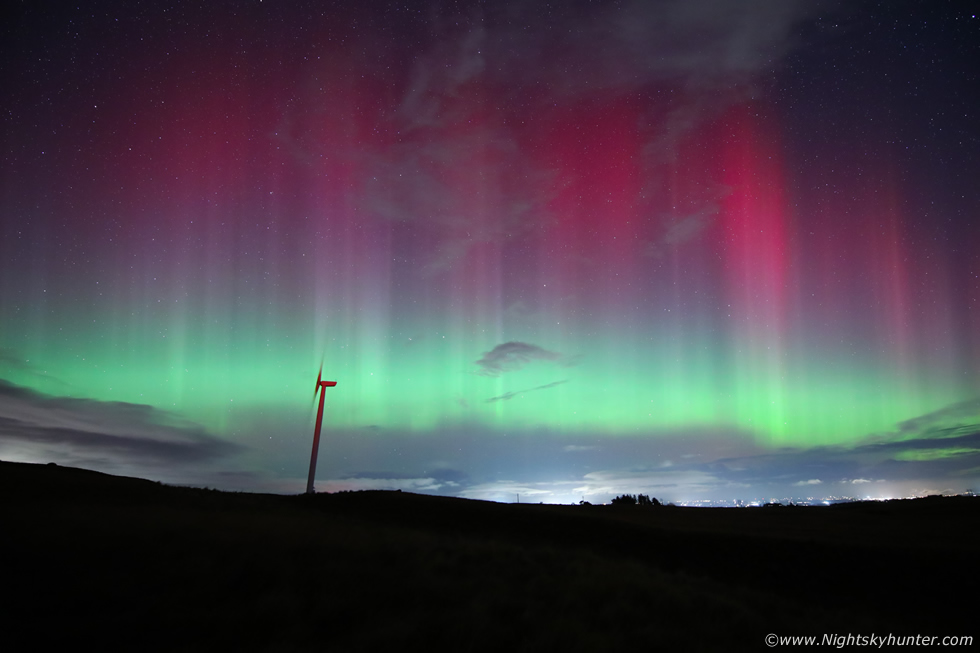 |
We could see green, red, orange and yellow colours easily with the naked eye and of course they came out vibrant on camera. Conor and I were of the opinion that this was the best aurora we had seen since the last solar maximum a very long time ago. It actually reminded us of our younger days when we got spoiled by amazing aurora displays, this was actually what we would call the basic standard of aurora we were used to back then, you just know you are near solar maximum when you are getting rays and colours like this.
 |
One of my favorites from the night, it almost looked like a painting. To the naked eye the beams looked like a celestial katana slicing through the sky, we could see them cutting through the passing darker tropospheric cloud drifting past which was spectacular to watch. At this moment the storm had reached G3 levels or a KP of 7.
 |
We were just all delighted to be together to witness the spectacle. You can imagine the 'sword slicing' in this image bottom left of centre, it really did look like our magnetosphere was putting up a heck of a fight trying to shield the attack from this solar storm.
 |
Crop sensor at 10mm on auto white balance in comparison to tungsten white balance which I used for the full frame imagery. After this the outburst began to subside back to a lower arc with fainter rays, we had done well, two outbursts and five hours of constant aurora action. I was starting to really feel the cold as the breeze had picked up on the hill however I didn't want to miss any further activity. Colleen Webb then appeared in the car park so we decided to meet her soon.
 |
Before heading back to lower ground I took a few more exposures of the W skyline and to my surprise the red beam was still there. We thought it was STEVE so took more images to document the event. It looked like a red fanning laser beam shooting up from the W, then crossed the zenith near Jupiter and the Gegenschein then all the way down to the E horizon not far to the left of Orion. This was W, I could faintly see it with the naked eye here tilted at an angle to the left of the Milky Way.
 |
Facing S and overhead (zenith) where the beam passed between Jupiter and M31, I could see a section of this with the naked eye
 |
SE passing through the Pleiades, Taurus and northern Orion, I also have images of it going down to the E but didn't want to overdo the images here. I didn't know until two days later when I saw an update on spaceweather.com that this wasn't STEVE, in fact, it was another atmospheric phenomena called SARs or 'Stable Auroral Red arcs', it's thought that SARs eventually evolves into STEVE, in fact, if you go back to the first images of STEVE on this report and look carefully you will see the red beam of SARs beside it. Myself and everyone else who captured STEVE this evening in all likelihood captured the moment when SARs was evolving into STEVE!, what a night of personal discovery indeed.
We stood around the cars for a while chatting about the display and keeping an eye out in case another outburst happened however it looked like the storm was subsiding and it was already after midnight so we decided to call it a night. Everyone drove home happy and content and I know that some of them are still buzzing for many days after the event. Looking back on it my anxiety and instincts during the daylight hours had been well founded, little did I know that we would be witnessing STEVE and SARs for the first time in our lives. This goes to show that the night sky is always a place were exciting and unexpected wonders can happen and why it's important to never stop looking up.
Full time lapse showing STEVE, glimpses of SARs and various aspects of the main aurora captured with the Canon 5D Mark IV and Canon 600D. If you missed this aurora then don't feel bad, trust me when I say that bigger and ever better displays are coming, not only on the months ahead but also for the next few years as we experience the glory of solar maximum, and some of those future displays will be life changing events for some. Thanks very much for reading.
Martin McKenna